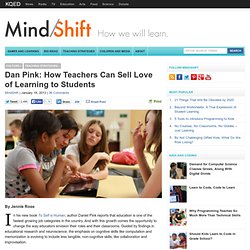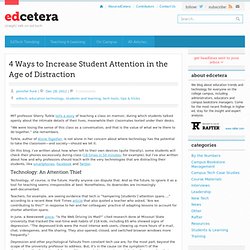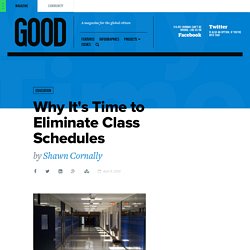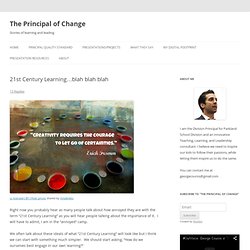

Dan Pink: How Teachers Can Sell Love of Learning to Students. By Jennie Rose In his new book To Sell is Human, author Daniel Pink reports that education is one of the fastest growing job categories in the country.

And with this growth comes the opportunity to change the way educators envision their roles and their classrooms. Guided by findings in educational research and neuroscience, the emphasis on cognitive skills like computation and memorization is evolving to include less tangible, non-cognitive skills, like collaboration and improvisation. Jobs in education, Pink said in a recent interview, are all about moving other people, changing their behavior, like getting kids to pay attention in class; getting teens to understand they need to look at their future and to therefore study harder.
At the center of all this persuasion is selling: educators are sellers of ideas. 8 Things to Look For in Today’s Classroom. As I think that leaders should be able to describe what they are looking for in schools I have thought of eight things that I really want to see in today’s classroom.

I really believe that classrooms need to be learner focused. This is not simply that students are creating but that they are also having opportunities to follow their interests and explore passions.1 The teacher should embody learning as well. Will Richardson recently wrote this in a comment on one of my recent posts on what teachers need to be like in our current day and the focus that needs to be on learning: …we need teachers who are masters at developing kids as learners who are adept at sense making around their own goals.
Good Read: Highlighting Is a Waste of Time: The Best and Worst Learning Techniques. Manager or Leader: Which Are You? There has always been an on-going debate on the differences between a leader and a manager.

Many have asserted that leaders have followers, while managers have subordinates. Reading numerous articles on management and leadership styles had revealed to me several core differences between the two which would have probably resulted in such a portrayal. (Image Source: whatedsaid) That said, I’ve come to believe that such differences exist on a continuum, where on one extreme you can be a great manager and on the other extreme, you can be considered a true blue leader. Most of us will fall somewhere in the middle as both manager and leader, depending on the circumstances we face. Elizabeth English: Why So Many Schools Remain Penitentiaries of Boredom. "It's harder to change a school than it is to move a graveyard.

" Or, as it's also been said, "It's harder to change a history course than it is to change history. " I think we can all agree that our schools should be among our most dynamic and innovative institutions; but despite the endless talk about school reform, they remain among our most ossified. Take a look at the typical American classroom, public or independent, urban or suburban, and what you will see looks very much like the classrooms of the 19th century.
Yes, slates have been replaced (in most places) with digital tools, but the structure signals the musty past: teacher as authoritative source of knowledge, student as tabula rasa. Or take the structure of the school day itself, typically divided into seven 45 minute classes. And it's not just the structure of schools that is chained to the past. Authentic learning at its core is about doing, creating, constructing. Embedded Inquiry. You know how when you have an epiphany and then wonder how you could have ever not known that thing you just realized?

That happened to me today while I was speaking with Chris Pedersen, a colleague at Rockridge. He had just told me about his lesson when it hit me: embedded inquiry – that’s what works. Dylan Wiliam published a book recently called Embedded Formative Assessment. Believing in Students: The Power to Make a Difference. After a morning Discipline With Dignity training, the high school principal and I walked to the cafeteria to eat lunch.

He said, "I love your session, but it's not practical. " I responded with my view that it was practical because it works -- but it’s just not easy. 4 Ways to Increase Student Attention in the Age of Distraction. MIT professor Sherry Turkle tells a story of teaching a class on memoir, during which students talked openly about the intimate details of their lives, meanwhile their classmates texted under their desks.

“We were losing the sense of this class as a conversation, and that is the value of what we’re there to do together,” she remembers. Turkle, author of Alone Together, is not alone in her concern about where technology has the potential to take the classroom—and society—should we let it. On this blog, I’ve written about how when left to their own devices (quite literally), some students will check their phones excessively during class (18 times in 50 minutes, for example), but I’ve also written about how and why professors should teach with the very technologies that are distracting their students, like smartphones, Facebook and Twitter. Technology: An Attention Thief Technology, of course, is the future. My “Top 3″ List for 2012 «
December 27, 2012 by cultureofyes My “Top 3″ blog list is becoming a bit of a tradition with previous Top 3 lists for 2011 (here) and 2010 (here).

This “top” list is an opportunity to review ideas that have become a big part or our learning over the past 12 months, which may have been missed in the “drinking from the firehose” approach (what has become social media and the Internet). I continue to shuffle the categories, trying to take a different approach to these year-end lists. They are a great way to raise topics, discussion, debate, and perhaps shed some light onto areas deserving more attention (or topics missed) as the year went on. Why It's Time to Eliminate Class Schedules. I spend a lot of time in a philosophical tug-of-war with students and parents over what grades mean, why we give them, and how they should be interpreted.

Parents want to know how their child is doing, students want to be left alone, and teachers just want everyone to think a bit more critically about the material. We end up with conflicting pressures, and a grading system that has overstepped its bounds with disastrous results for student psychology. Cheating, lying, extra credit for bringing in a box of Kleenex—it’s all the same disease. As I stare out across the ocean of students I teach everyday, I wonder if their obsession with grades comes from an unexpected source: the way we schedule their classes.
Perhaps clamoring for meaningless grades and inflated A’s is a side effect of the herd mentality present in schools and the schedules we use to create and maintain that mentality. How 17-Year-Old Nikhil Goyal Is Disrupting Education. At 17 years old, Nikhil Goyal is shaking up America’s education system. Goyal is a senior at Syosset High School, a public school in New York. While most high school students focus on athletics, academics, and socializing, Goyal aims to transform the American education system. Goyal’s book, One Size Does Not Fit All: A Student’s Assessment of School ,describes the flaws within America’s education system and provides solutions to fix the present challenges. He explains the importance of finding progressive leaders to transform our nation’s education system. A Simple Guide To 4 Complex Learning Theories. » Start with your strengths and focus on your bright spots I know this much is true. 21st Century Learning…blah blah blah.
Cc licensed ( BY ) flickr photo shared by mrsdkrebs Right now you probably hear as many people talk about how annoyed they are with the term “21st Century Learning” as you will hear people talking about the importance of it.

I will have to admit, I am in the “annoyed” camp. We often talk about these ideals of what “21st Century Learning” will look like but I think we can start with something much simpler. We should start asking, “How do we ourselves best engage in our own learning?” I was reminded of this the other day while at a conference and the presenter started the session by saying, “I would like to start by asking everyone to put away their mobile devices.” How many educators could sit through 4-6 hours of lectures daily, with worksheets, for 180-200 days of the year? Mike McKay » Secondary School Transformation Continued. In a previous blog entry, I touched on some of the drivers for secondary school transformation. It is complex work and well underway in various places, but typically one piece at a time. For system change to provide maximum benefit for kids, we need to align our efforts, learn from each other and gain more familiarity and confidence with new ways to support learning.
Here are a few more of the pieces that help to put the puzzle together: Step away from the assembly line secondary timetable/class schedule and the “seat time” foundation of the old teaching/learning dynamic. Encourage and resource flexible learning time and space, including the expansion of “hybrid” courses. Connected Learning. We All Want Flexibility « April 9, 2012 by cultureofyes If asked, most people would agree they could do well with more flexibility in their life – this is also true in the education field, and almost all education reform movements include a call for greater flexibility. Of course, this can mean something very different from one person to the next. For me, flexibility is about giving more choice and ownership. I shared this slide (below) in a recent presentation giving an overview of what I think flexibility means in the education context.
Just as we talk about students owning their own learning as an optimal goal, the same is true for adults; the more we own our learning (and teaching), the more optimal and powerful a system we will have. The process repeats itself in schools with principals giving teachers the ability to be flexible, and teachers doing the same for students in giving students choice in the what and the how of their learning.
Granted, flexibility is only part of the equation. Successful School Leaders Today Need to Harness Technology & Social Media. School leadership is complex. It’s often an enigma. It is simultaneously invigorating and exhausting. School and system leaders are pulled in hundreds of directions by hundreds of constituents every second of the day. Having the passion, skills, strategies, and with-it-ness to thrive in a position of school leadership requires, in part, taking the opportunity to learn from the experiences of other leaders.
I had the opportunity to review William Sterrett’s recent publication, Insights into Action: Successful School Leaders Share What Works, published by ASCD. It was with great interest that I read this new book, curious if and how the author would encourage his readers to become connected learners and leaders — to harness technology and social media tools to enhance communication, collaboration, and learning opportunities for those in the organization and school community. Connected learning & leadership. I'm speaking at Red Deer College on April 4. Classroom without walls. To do whatever you tell me. Do you remember that scene from Forrest Gump when Gump joined the army and met his Drill Sergeant? Drill Sergeant: Gump! What's your sole purpose in this army? Forrest Gump: To do whatever you tell me, drill sergeant! Drill Sergeant: God damn it, Gump!
Fun Failure: How to Make Learning Irresistible. Culture. Future of Teaching: Swedish School System Goes Classroom-Free. Last week, GOOD posted a short profile of a school system in Sweden that has done away with classrooms. How To Start a Meditation Program in Your School. Middle school teacher Rose Ludwig rings the bell to begin Quiet Time, a daily program of silence and optional meditation for students. An Open Letter to Educators. Do Students Know Enough Smart Learning Strategies? Teaching Strategies. My Top Ten in Ten Days – Celebrating my 100th Blog Post – 1/10. Everything you know about curriculum may be wrong. Really. UPDATE: Cool. Schools Are Prisons. Did You Attend a School Like This? Livebinders.
21st Century Learning. What to Look for in a Classroom. “We Don’t Need No Stink’n Textbooks” #Beyondthetextbook. March 20, 2012 by tomwhitby In order for educators to teach kids, they need something to teach. Videos to help you rethink education, learning, & school. Having children causes one to (re)think seriously about education and the role of school. Education obviously is the most powerful thing in the world.
The Best Ideas for Our Schools. This past week I was fortunate to attend the NASSP 2012 Annual Conference as a presenter, 2012 Digital Principal Award recipient, and most importantly a learner. On Friday morning I attended a session facilitated by Dr. Cooperative Catalyst. High Tech High. Stop Stealing Dreams – Seth Godin’s Manifesto on Transforming Education. Misguided Efforts in Educational Reform. Foundations: The Learning Landscape. Guest Blog: What's the Best Way to Teach "At-Risk" Students? Mike McKay » Means or Ends. Where’s our Focus?
You can never replace the teacher. Or can you? 8 ways to learn without teachers. 21 Things That Will be Obsolete in 2020. Four game changers. What Americans Keep Ignoring About Finland's School Success - Anu Partanen - National.